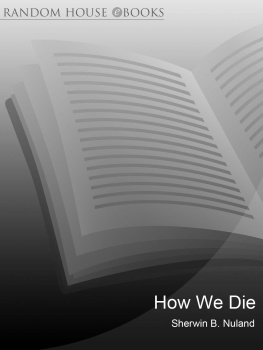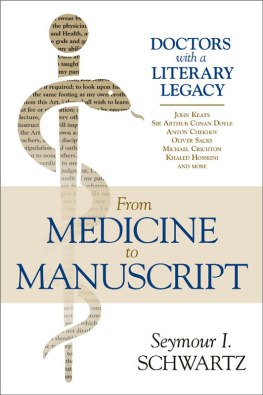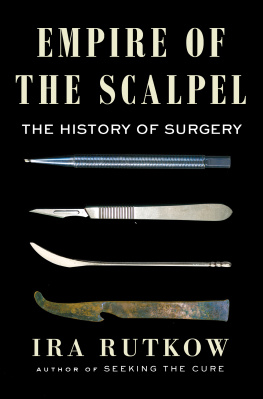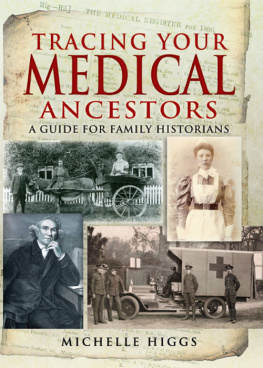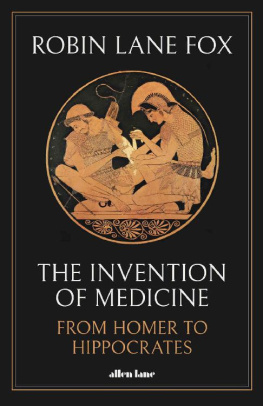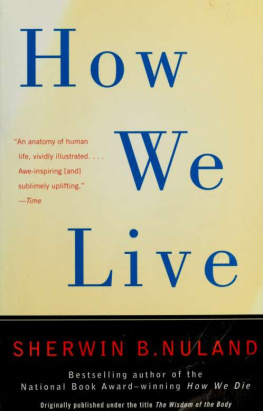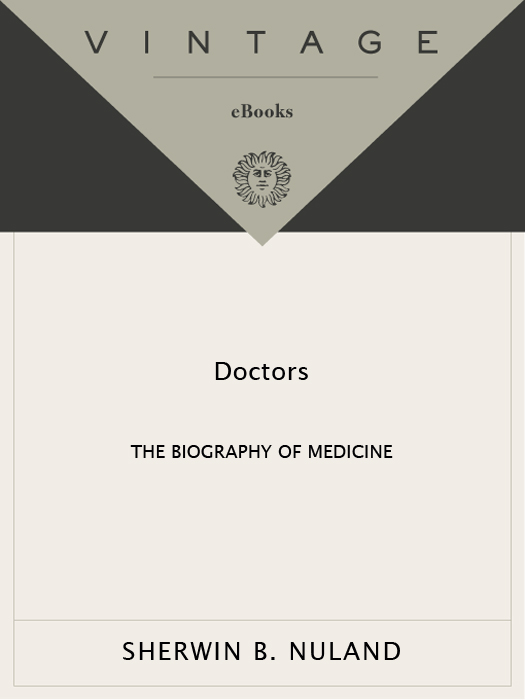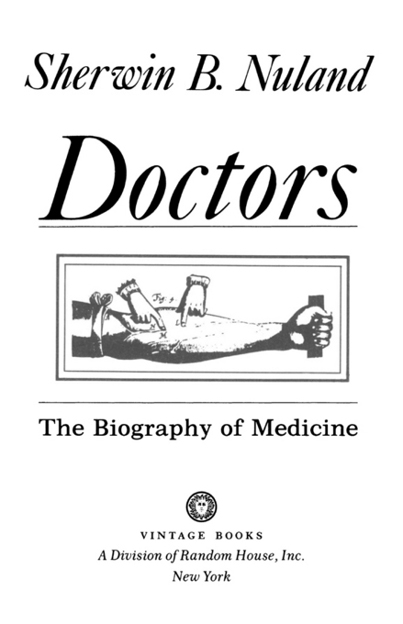Sherwin B. Nuland
Doctors
Sherwin B. Nuland, M.D., is the author of How We Die: Reflections on Lifes Final Chapter, which won the National Book Award in 1994, and How We Live. In addition to his numerous articles for medical publications, he has written for The New Yorker, the New York Times, The New Republic, Time, and the New York Review of Books. Dr. Nuland died in 2014.
BOOKS BY S HERWIN B. N ULAND
Lost in America
How We Live
(originally published as The Wisdom of the Body)
How We Die: Reflections on Lifes Final Chapter
The Face of Mercy
Medicine: The Art of Healing
Doctors: The Biography of Medicine
The Origins of Anesthesia
S ECOND V INTAGE B OOKS E DITION , J ANUARY 1995
Copyright 1988 by Sherwin B. Nuland
All rights reserved under International and Pan-American Copyright Conventions. Published in the United States by Random House, Inc., New York, and simultaneously in Canada by Random House of Canada Limited, Toronto. Originally published, in hardcover, by Alfred A. Knopf, Inc., New York,
in 1988.
The chapters on Hippocrates, Par, Morgagni, Hunter, Halsted, and anesthesia were originally published, in somewhat different form, in the Notes from the Editors which accompany the Gryphon Editions facsimile volumes of The Genuine Works of Hippocrates, The Apologie and Treatise of Ambroise Par, Morgagnis The Seats and Causes of Disease, John Hunters Treatise on the Blood, Inflammation and Gunshot Wounds, William Halsteds Surgical Papers, and Origins of Anesthesia by Sherwin B. Nuland, published in The Classics of Medicine Library. This material is adapted and reprinted by permission of the publisher, Gryphon Editions, Ltd., 3100
Independence Drive, Birmingham, Alabama 35209.
Library of Congress Cataloging-in-Publication Data
Nuland, Sherwin B.
Doctors: the biography of medicine.
Reprint. Originally published: New York: Knopf, 1988.
1. PhysiciansBiography. 2. MedicineHistory.
I. Title.
[ R 134. N 85 1989] 610.922[ B ] 88-40370
eISBN: 978-0-307-80789-2
v3.1_r1
To Sarah, to Sal
This book, and my life, are gifts from you.
O. A. G. S.
The history of medicine is, in fact, the history of humanity itself, with its ups and downs, its brave aspirations after truth and finality, its pathetic failures. The subject may be treated variously as a pageant, an array of books, a procession of characters, a succession of theories, an exposition of human ineptitudes, or as the very bone and marrow of cultural history. As Matthew Arnold said of the Acta Sanctorum, All human life is there.
Fielding Garrison, 1913
Contents
1 THE TOTEM OF MEDICINE
Hippocrates
2 THE PARADOX OF PERGAMON
Galen
3 THE REAWAKENING
Andreas Vesalius and the Renaissance of Medicine
4 THE GENTLE SURGEON
Ambroise Par
5 NATURE HERSELF MUST BE OUR ADVISOR
William Harveys Discovery of the Circulation of the Blood
6 THE NEW MEDICINE
The Anatomical Concept of Giovanni Morgagni
7 WHY THE LEAVES CHANGED COLOR IN THE AUTUMN
Surgery, Science, and John Hunter
8 WITHOUT DIAGNOSIS, THERE IS NO RATIONAL TREATMENT
Ren Laennec, Inventor of the Stethoscope
9 THE GERM THEORY BEFORE GERMS
The Enigma of Ignac Semmelweis
10 SURGERY WITHOUT PAIN
The Origins of General Anesthesia
11 THE FUNDAMENTAL UNIT OF LIFE
Sick Cells, Microscopes, and Rudolf Virchow
12 TO TEND THE FLESHLY TABERNACLE OF THE IMMORTAL SPIRIT
Joseph Listers Antiseptic Surgery
13 MEDICAL SCIENCE COMES TO AMERICA
William Stewart Halsted of Johns Hopkins
14 A TRIUMPH OF TWENTIETH-CENTURY MEDICINE
Helen Taussig and the Blue-Baby Operation
15 NEW HEARTS FOR OLD
The Story of Transplantation
Acknowledgments
Tattooed onto the surface of my psyche is a pedagogical motto that was thundered at me and my college-biology classmates four decades ago: in order to receive a proper grade, the answer to every examination essay-question must fulfill the five criteria of being clear, consecutive, concise, complete, and correct; anything less would be considered defective. Delivered by a crusty, nematodeloving misanthrope who had only disdain for those of us who cared about mammals (or, heaven forbid, planned careers in clinical medicine), that ringing admonition has echoed in my thoughts ever since, on each new occasion of putting thoughts to paper. I have treated Professor Horace Wesley Stunkards dictum like an article of religious faith, perhaps to assuage my guilt at letting him down when I rejected the laboratory in favor of the clinic. More likely, though, I remember his alliterative adjectives because they add up to sound advice.
With Stunkard in mind, I ran the sundry chapters of this volume through a gauntlet of readers. A book, of course, is not an exam essay, and it is impossible (and surely not even desirable) to make it complete. To replace that one c, I added two others: cohesive and consistent. If the reader finds that the Stunkardian criteria have been met, it is to the credit of those colleagues and friends who were willing to take potshots at this book during the course of its writing; if there are deficiencies, it is only because I have sometimes not heeded their counsel. It is not enough to list names in acknowledgment; what follows is meant as a tribute, not only in gratitude for the contributions of my gauntlet-gang, but also for their skillful pummeling.
My wife, Sarah Peterson, has always been my first editor, and my toughest. Her specialty is the recognition of rambling and the discouragement of drift. Fortunate indeed is the author whose initial manuscript-surveyer knows exactly what he is trying to say, and insists that he get on with it. I would like to write much more about the contributions of this particular editor, but she would make me delete it, on the ground that it sounds sentimental and sappy.
After the scrutiny of Sarah, certain chapters were sent off to colleagues who are especially knowledgeable about some particular topic or period. Every one of those essays was returned with comments or suggestions that were extremely helpful. In alphabetical order, I am in debt to: Raymond Edwards, Marc Lorber, Robert Massey, Jeremy Norman, John Harley Warner, and Ruth Whittemore.
I am particularly grateful to four other friends for applying their critical faculties to the entire volume. They are, respectively, a teacher of literacy, a medical historian, a biomedical scientist, and the director of a library of medical history: Joan Behar, Thomas Forbes, Ion Gresser, and Ferenc Gyorgyey. To Ferenc, a special tribute: without our countless hours of discussion, his vast knowledge of the medical-historical literature, and the generosity with which he made available the treasures of his unique library, this book would have died a-borning; without the inspiration of his friendship, the project would never have been conceivedKsznm kedves bartom!
I began to write a series of medical biographies at the suggestion of Leslie B. Adams, Jr., approximately five years ago. His Classics of Medicine Library published a group of some fifteen of my monographs and my book,


